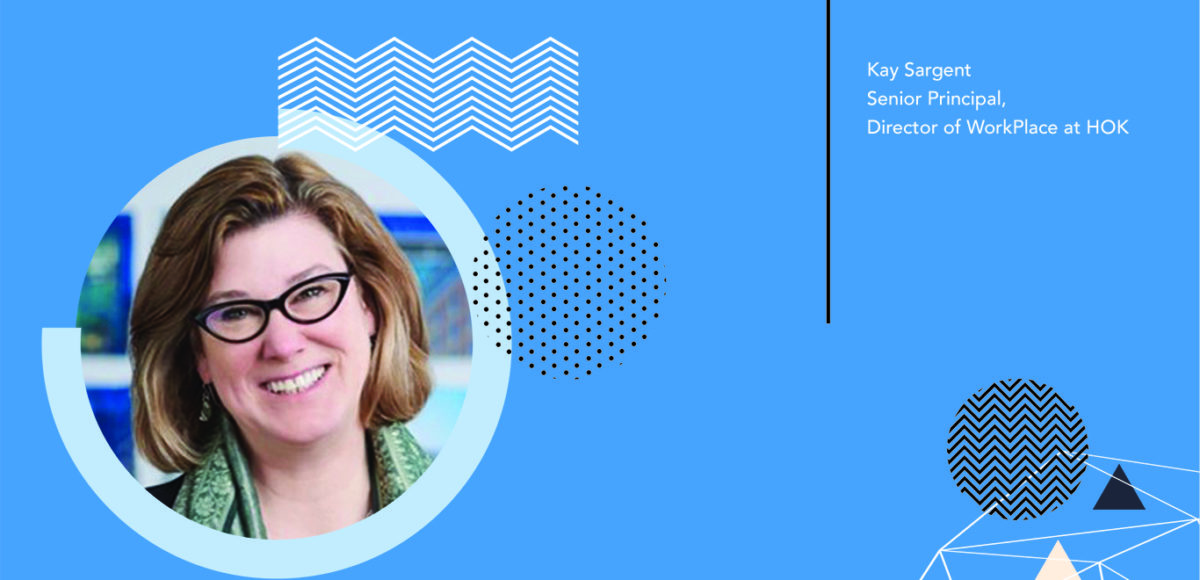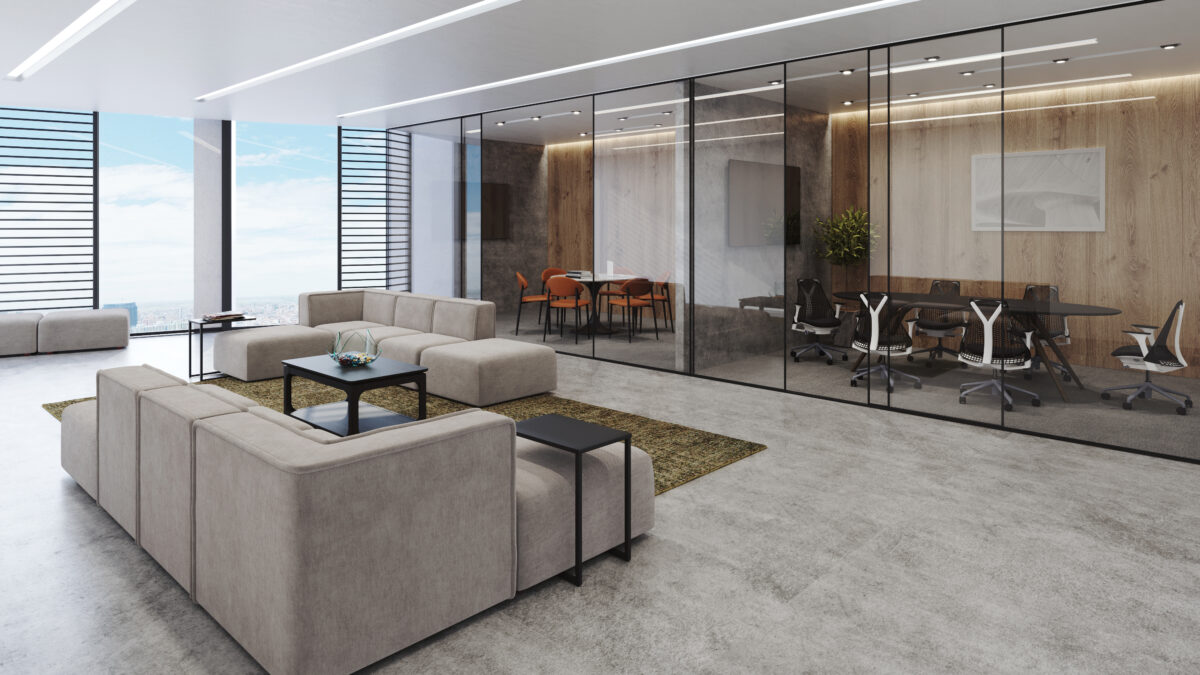This article is part of the “CORT Workplace Talk” series where Melanie Jones, CORT’s National Director, CRE Partnerships, sits down with thought leaders in commercial real estate to discuss advancements, insights, and trends within the industry. Sit back and learn more about CRE and how CORT Furniture Rental can benefit your organization.
If you missed part 1 of my “Redesign of Design” conversation, I encourage you to check it out. Kay and I connected at CoreNet Global 2022 in Seattle. During a presentation Kay, challenged the audience, “Do you really want to own furniture“?
Anyone who knows me can understand why this was a spectacular moment. Kay Sargent, Senior Principal, Director of WorkPlace at HOK, a globally recognized thought-leader in the Commercial Real Estate industry, challenging others to at least consider the concept of access to furniture instead of ownership—the message I share daily as a bit of a Furniture-as-a-Service activist!
We ended part one with this thought-starter:
Do you see a day when design firms come directly to CORT and perhaps tap into our CORT Space360™ platform that’s loaded with product and pricing to support flexible space and lease terms?
Read on for the exciting second part of this insightful conversation!
Kay Sargent: I think it begs a bigger question, and it’s a question we now ask clients, “Why do you want to own anything that ties you down or locks you in, especially furniture?” We asked this question before COVID, but I think it’s even more critical now
Our findings and research have shown that access is the new ownership. You don’t have to own everything. As I mentioned during my presentation at CoreNet Global, you don’t have to own a tricked-out conference center that will become obsolete because all the stuff in it is changing so rapidly and the needs of your organization are too. Same goes for furniture. Perhaps a more innovative thing to do is to leverage a subscription model like CORT’s Furniture-as-a-Service™.
Jones: In my conversations, I liken our FaaS model to Uber and Airbnb because now people understand the innovation and application of the usership approach. It won’t be long, and furniture, IT, art, etc.… will be viewed in the same way.
Sargent: We know our clients’ needs will change. Why buy something that is going to “ugly out,” or become obsolete before it wears out.
Jones: Your comment reminds me of this CoreNet piece that Vik Aggarwal and I created, he talks about making furniture purchase decisions today that will provide seating for future employees who are kids in middle school today. Interesting to think about it like that.
Sargent: So true. As we go into this period of testing different scenarios– leveraging access instead of ownership will be essential. Maybe down the line, the leadership teams decide to purchase because they have had the opportunity to try it, to test it, and are comfortable with the offering. Even then though, they may want to consider what’s going to come out next year that they don’t even know about. It’s not only about present flexibility, but it enables one to be future-ready.
Jones: Let me ask you this. In our model, the furniture selection is very deep. As Todd Simpson, the Managing Director of our team shares in this WorkBold podcast “the product is situated strategically across the US, just minutes from most major markets. We have everything needed, in any quantity, for any period of time.”
We can have a client up and running with hundreds of work surfaces along with necessary huddle & conference, soft seating, lobbies, breakrooms, and so forth within a few days to a couple of weeks.
The other side of that coin is that the selection is not as wide as a typical furniture dealer. Do you see a day when your clients are willing to exchange the latest and greatest chairs, as an example, for a model with a different financial strategy, offers reduced risks and capital, and enhanced flexibility?
Sargent: Furniture needs to be responsive. Let’s say we decide to install collaborative furniture right now because we think that’s why people are coming back into shared spaces.
But what happens, say three years from now? We may find collaboration areas are not nearly as important as heads-down workspace, and we need to shift the environments. If you’re locked into furniture and bought everything, you’re stuck with the decisions. Many companies that are going through change or rapid growth need a model enables a reassessment or the ability to refresh spaces. The FaaS model gives them more options.
Jones: Another benefit of this approach is it takes people out of the furniture and asset management business. Especially for landlords who want the results on new tenants without the hassle of managing furniture.
Sargent: Then there is the horrible question every client deals with when looking into a new product. “What do we do with all the old furniture, and where does it go?”
Often we’re so stuck in our ways of doing things that we need to start thinking about how can we do something a little bit differently?
Right now we have several clients who are intrigued with this model. But it often dies on the vine quickly because teams have to rethink their procurement process, and that’s just not something many are ready to do. But it solves many problems that our clients have.
Jones: The momentum is building; there is zero doubt in my mind. When you align the focus on sustainability, circularity with the need for flexibility, reducing risks, and dealing with unknowns, it’s just a matter of time that we see the shifts in the process you mention.
We need people like Kay Sargent to help raise awareness. The mission for me is so invigorating and fuels me to be bold!
Another question. Do your clients come to you for consultation on portfolio optimization, space options, and lease term duration discussions?
Sargent: Yeah, absolutely. We’re advising many clients with their corporate real estate strategy. The ground is shifting, but many people are still in the wait-and-see stage. But most have embraced the notion that the way we work is shifting too.
Most of our clients have retained their space but plan to use it differently going forward. There is a shift from dedicated individual space to more shared space and a bit more generosity of space. In other words, they’re not densifying to the same level that they did before COVID
Jones: Do clients discuss pressure from investors, board of directors, or employees to become more sustainable?
Sargent: Oh, absolutely, yes. ESG is huge right now and has been for a few years. Most of our clients are looking for space solutions that help meet their goals and make their space more sustainable, diverse, inclusive and welcoming.
Jones: Do you feel the flexible furniture model touches on sustainability in clients’ eyes?
Sargent: Often, those who own furniture capture a seven-year depreciation and then hold the furniture until they move or renovate and upgrade. But where does all that furniture end up? Giving it back and not having the burden of ownership and having the ability to have it repurposed, renewed, and reused is enormous. Circularity is becoming a greater focus for many companies looking to reduce their carbon footprint.
We’ve got to get away from this disposable economy where everything is tossed even though it’s still perfectly good. The same thing goes for buildings, hence why we are seeing an uptick in adaptive reuse.
Jones: Adaptive reuse is an area we are also starting to see growth and interest in our solution. Those focused on adaptive reuse are naturally drawn to a circular model for furniture within some of those buildings. This just makes sense.
Sargent: We have a whole group of individuals aggressively working on this. What should and should not be recommended and specified to our clients.
I foresee a time soon where design firms will say, “unless you can prove the furniture and other interior materials has some circularity, will not end up in a landfill, and either be reused or repurposed, we don’t want it.” This topic will continue to evolve and become more critical.
Jones: Kay, what keeps you inspired to drive change and articulate your findings and visions?
Sargent: We are living in unprecedented times and witnessing the evolution of how we live and work. Design can be a powerful tool in that evolution. As designers, we need to balance what we have always done well, the art of design, with the emerging science of design.
Today there is a renewed focus on the fact that the most valuable asset in any space is the people. After all, people are the reason we create space in the first place. We can’t lose sight of the fact that we are human. We need to design spaces that reflect that and reflect our humanity and ensure social equity and inclusion. By creating environments that support wellbeing, engagement and inspire those within them, we can drive powerful outcomes. We need to think beyond the traditional ways we have designed space.
As we enter into an era where things are evolving at a rapid pace the sharing economy, safety, wellbeing, technological advances, and globalization are amongst the factors impacting our lives and our environments. We need to design with the courage to define the next generation of great places if we plan to refine and transform the way we work, live, learn and play. As the lines between those activities blur more and more today, we are seeing design elements from previously siloed sectors blur as well. Hospitality, healthcare, retail, and education sectors are influencing the corporate workplace and vice versa. After all, we are no longer designing environments – we are designing the experience.
Jones: What a treat to hear thoughts from Kay. As we move forward in 2022 many will be grateful to see the ground stop shifting and allow experimentation, testing, and exploration to unfold the next chapters in workplace experience.
About Kay Sargent
With more than 35 years of experience, Kay is a recognized expert on workplace design and strategy issues. She is an award-winning designer who has worked with several Fortune 500 companies to optimize their global real estate portfolios and create innovative work environments based on their unique organizational DNA. As Co-Director of HOK’s WorkPlace team, a practice that supports organizations undertaking multiple projects in various locations, and a member of HOK’s Board of Directors, Kay is responsible for helping clients redefine how, when and where their people work, and supports a holistic design approach that integrates an organization’s people, processes and technology. She was recently selected from her field of peers to provide Congressional Subject Matter Expert Testimony to the U.S. House of Representatives on “Federal Real Estate Post-COVID-19: A View from The Private Sector.”
In 2020 Kay was named ASID’s Designer of Distinction for the year. Kay is considered an industry thought leaders on workplace. She has authored multiple white papers and articles on a variety of design related topics including wellbeing; next gen workforce; technologies impact on the workplace; space fusion and the rise of the human factor.
Kay currently serves on the AVIXA Board of Directors; the National ASID Foundation Research Taskforce, the IWBI Mind Advisory Team and the Advisory Board for WorkDesign Magazine. She was recently appointed to the George Washington University Customer Experience Certificate Program Advisory Council. During her career she has also served on the International Boards of CoreNet Global and IFI – International Federation of Interior Designers /Architects, the Boards of ASID, IIDA and NCQLP and the Advisory Board of Virginia Tech School of Architecture and Design and NVCC. She is an active member of IFMA and co-founder of the IFMA Workplace Evoluntionaries, WE community and serves as an Executive committee for WE. Kay is committed to mentoring the next generation of designers and as such mentors multiple individuals within HOK and across the industry. She is also a Founder of the DC Chapter of UPWARD, a global network dedicated to the professional advancement of women in the workplace.
About Melanie Jones
Melanie, a self-described, Furniture-as-a-Service™ activist and is a passionate leader on the Strategic Business Development team at CORT. Her mission is to demonstrate the value of a furniture subscription (access instead of ownership) to commercial real estate leaders for their clients.
Melanie served on the Board of CoreNet Atlanta and is a graduate of the Real Innovation Academy. Her interests are sustainability, circularity, climate change, and helping others.






